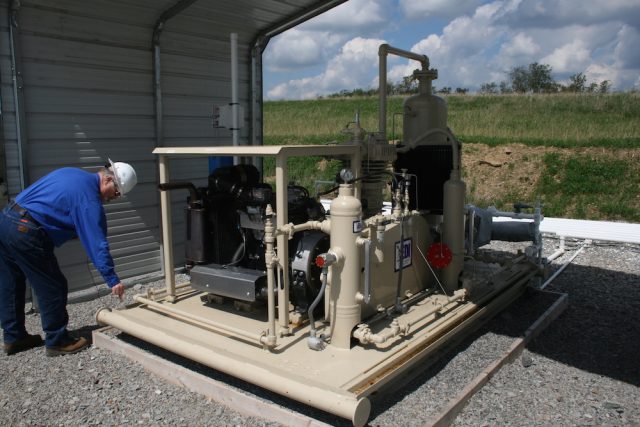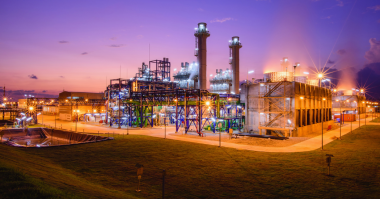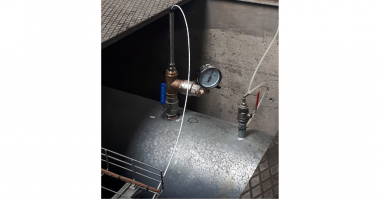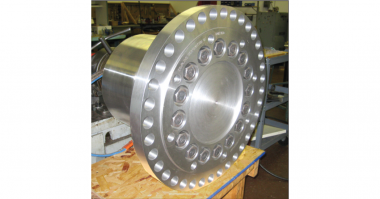As the use of vapor-recovery units at oilfield storage-tank facilities grows, so does the need to understand that proper skid-assembly installation will help guarantee their reliable performance
By Glenn Webb
Increased production in such prominent shale fields as the Bakken in North Dakota, Eagle Ford in Texas, Niobrara in Colorado, and Marcellus and Utica in New York, Ohio, West Virginia and Pennsylvania, has increased the demand for gathering, transport and terminal systems that can store raw crude oil and natural gas until it can be shipped via truck, train or pipeline for refinement and consumption. The increase in oilfield activity has also meant a corresponding increase in the amount of vapors that are created and emitted during production, transportation and storage. To prevent the escape and loss of these vapors—which are saleable assets in addition to being potentially dangerous to the environment—many operators are turning to the installation of vapor-recovery units (VRUs) at their oilfield storage sites.
These VRUs only operate at peak efficiency and effectiveness, however, if they are correctly installed. This article will show how the proper installation of a VRU skid assembly for in-the-field use will optimize the performance of the equipment while eliminating many environmental and maintenance concerns.
The Challenge
 The growth in the amount of vapors that are a by-product of oilfield production activities is not going away. Neither is the attention that regulatory agencies will be paying to the levels of vapors that are emitted into the atmosphere and whether or not they can be harmful. That’s because many oilfield vapors—compounds like benzene, toluene, ethyl-benzene and xylene—have been classified as Hazardous Air Pollutants (HAPs) or Volatile Organic Compounds (VOCs) by the U.S. Environmental Protection Agency (EPA).
The growth in the amount of vapors that are a by-product of oilfield production activities is not going away. Neither is the attention that regulatory agencies will be paying to the levels of vapors that are emitted into the atmosphere and whether or not they can be harmful. That’s because many oilfield vapors—compounds like benzene, toluene, ethyl-benzene and xylene—have been classified as Hazardous Air Pollutants (HAPs) or Volatile Organic Compounds (VOCs) by the U.S. Environmental Protection Agency (EPA).
Because of this, the operators of oilfield storage facilities must closely monitor the amount of vapors that are being emitted at their sites (if any) and meet the emission thresholds of the Title V Operating Permit Program of the Clean Air Act, which were put into place in 1990. According to Title V, regulated pollutant thresholds for stationary sources include 100 tons per year (tpy) for criteria pollutants, and from 10 tpy per year for one HAP, or 25 tpy for multiple HAPs.
Oilfield storage-facility operators also must be aware of the EPA’s New Source Performance Standard 40 CFR, Part 60, Subpart OOOO, which became law in 2012 and has come to be known as the “Quad O” regulation. Quad O establishes emissions standards and compliance schedules for the control of VOCs and sulfur dioxide (SO2) emissions from storage tanks that temporarily house liquids produced during oil and gas production.
Enter the VRU. Basically defined, a VRU is a system composed of a scrubber, a compressor, a driver and controls whose main purpose is to recover vapors that are formed inside completely sealed crude-oil or condensate storage tanks. During the VRU’s operation, the controls detect pressure variations inside the tank and turn the compressor on and off as the interior pressure exceeds or falls below pre-determined settings. When the compressor is running, it passes the vapors through the scrubber, where any liquid is trapped and returned to the tank, while the vapor is recovered and compressed into natural gas lines.
For use in the oilfield, the components of the VRU are generally installed on a skid assembly, with the skid able to be easily moved and installed as one complete unit. Operational problems arise when that skid is not installed or anchored properly to the ground. Most issues during the operation of a poorly installed VRU skid show up at or near the compressor, which is the heart of the VRU system.
 It is a given that all reciprocating-type compressors will produce some shaking forces and moments, which can be caused by a wide array of operational characteristics, including speed, height, cylinder orientation, intake/discharge pressures, single- or double-acting operation, compression ratio and application conditions like gas composition, or site, placement and environmental variations. If those forces or moments are not properly absorbed into the mounting or foundation of the operating system, then vibration of the compressor can occur.
It is a given that all reciprocating-type compressors will produce some shaking forces and moments, which can be caused by a wide array of operational characteristics, including speed, height, cylinder orientation, intake/discharge pressures, single- or double-acting operation, compression ratio and application conditions like gas composition, or site, placement and environmental variations. If those forces or moments are not properly absorbed into the mounting or foundation of the operating system, then vibration of the compressor can occur.
The Solution
For more than a century, Blackmer®, Grand Rapids, MI, USA, a leading brand from PSG®, a Dover company, Oakbrook Terrace, IL, USA, has been building a reputation as a reliable manufacturer and provider of equipment that can be used in oilfield activities. This positive reputation extends to its various lines of Oil-Free Reciprocating Gas Compressors, namely the HD, HDS and NG Series models. All can reliably and effectively be used as part of an in-the-oilfield VRU that can optimize operational performance and production while reducing costly downtime and maintenance.
However, there is one very important caveat…the VRU base and skid assembly must be installed correctly. Blackmer has recently noticed that a number of reciprocating compressor oilfield VRU installations were not operating at peak performance. After investigating these issues, it was found that the issues were not being caused by any individual VRU components; instead it was found that the skid assemblies on these installations were not properly designed and/or installed. Prolonged operation with an improperly designed skid or poor foundation can damage the compressor and compromise the VRU’s overall operational effectiveness and reliability.
To help educate the industry and optimize the performance of storage-facility VRUs and their components, Blackmer has produced a video titled “Does Your VRU Compressor Vibrate? It Shouldn’t,” that has been designed to explain and illustrate the correct way to prevent vibration in the skid assembly. Proper skid assembly is paramount because when operating at peak speeds, reciprocating compressors can produce unbalanced forces.
Specifically, the short video, which was produced with the help of Electronic Design for Industry (EDI), at its test facility in Ohio, spells out the following steps that should be taken and parameters that should be met for proper skid assembly:
- The compressor should be anchored to a baseplate (or skid)
 that is at least four times the compressor’s weight
that is at least four times the compressor’s weight - The baseplate with the compressor and other VRU components should be bolted to a concrete slab/pad
- The concrete slab/pad should be situated on a level surface
- The pad should be prepared and graded, if necessary
- The baseplate skid should never be installed on non-compacted soil
If these simple rules for skid-assembly installation are followed, the amount and severity of the forces and moments that occur during compressor operation will be minimized, resulting in almost vibration-free operation that will help optimize the VRU’s performance and longevity.
Conclusion

In the fast-growing oil and gas industry, speed, portability and reliability are key factors in optimizing production times and the bottom line. There is now an almost constant need for the installation of VRUs in the oilfield as production operations continue to accelerate. VRUs themselves are complex, highly engineered systems designed for reliable performance in a variety of harsh operating conditions. However, the oilfield’s rugged terrain, combined with the need for rapid deployment and a reduction in site-time preparation, can compromise VRU installation. OEMs and system fabricators who follow the tips in Blackmer’s video and take the time to install the VRU’s skid assembly correctly will find that any subsequent time and cost incurred because of downtime, repairs and maintenance will be greatly reduced.
To view a helpful video on this topic, please go to: http://www.psgdover.com/en/psgtv/videos-by-technology/psgtv-reciprocating-gas-compressors/item/5148-does-your-vru-compressor-vibrate-it-shouldnt
About the Author:
Glenn Webb is a Senior Product Specialist for Blackmer®, Grand Rapids, MI, USA, and can be reached at (616) 475-9354 or glenn.webb@psgdover.com. For more information on Blackmer’s full line of innovative and high-quality rotary vane and centrifugal pump and reciprocating compressor technologies, please go to www.blackmer.com or call (616) 241-1611. Blackmer is part of PSG®, a Dover company, Oakbrook Terrace, IL, USA. PSG is comprised of several leading pump brands, including Abaque®, Almatec®, Blackmer®, Ebsray®, EnviroGear®, GriswoldÔ, Mouvex®, NeptuneÔ, QuattroflowÔ, RedScrew™ and Wilden®. You can find more information on PSG at www.psgdover.com.





Comments